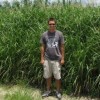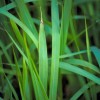 The bioenergy industry has primarily used Miscanthus for combustion in power plants. It has desirable properties of low water and ash contents following a dry-down period before harvest. Current research is focused on its potential as a biomass crop for direct combustion and for lignocellulosic conversion to ethanol and other biofuels. This 3-page fact sheet was written by John Erickson, Curtis Rainbolt, Yoana Newman, Lynn Sollenberger, and Zane Helsel, and published by the UF Department of Agronomy, September 2012.
The bioenergy industry has primarily used Miscanthus for combustion in power plants. It has desirable properties of low water and ash contents following a dry-down period before harvest. Current research is focused on its potential as a biomass crop for direct combustion and for lignocellulosic conversion to ethanol and other biofuels. This 3-page fact sheet was written by John Erickson, Curtis Rainbolt, Yoana Newman, Lynn Sollenberger, and Zane Helsel, and published by the UF Department of Agronomy, September 2012.
http://edis.ifas.ufl.edu/ag297
Tag: Poaceae (taxonomic family)
Cogongrass (Imperata cylindrica) Biology, Ecology, and Management in Florida Grazing Lands (SSAGR52/WG202)
 Cogongrass is found on every continent and is considered a weedy pest in 73 countries. In the U.S., cogongrass is found primarily in the Southeast. It was accidentally introduced into Alabama in the early 1900s, and purposely introduced as a potential forage and soil stabilizer in Florida (and other states) in the 1930s and early 1940s. However, soon after investigations began it was realized that cogongrass could be a weedy pest. Since its introduction, cogongrass has spread to nearly every county in Florida. In some cases, it has completely taken over pastures so that it is the only species present. This is a common thread where cogongrass invades; it quickly displaces desirable species and requires intensive management. This 5-page fact sheet was written by B. A. Sellers, J. A. Ferrell, G. E. MacDonald, K. A. Langeland, and S. L. Flory, and published by the UF Department of Agronomy, August 2012.
Cogongrass is found on every continent and is considered a weedy pest in 73 countries. In the U.S., cogongrass is found primarily in the Southeast. It was accidentally introduced into Alabama in the early 1900s, and purposely introduced as a potential forage and soil stabilizer in Florida (and other states) in the 1930s and early 1940s. However, soon after investigations began it was realized that cogongrass could be a weedy pest. Since its introduction, cogongrass has spread to nearly every county in Florida. In some cases, it has completely taken over pastures so that it is the only species present. This is a common thread where cogongrass invades; it quickly displaces desirable species and requires intensive management. This 5-page fact sheet was written by B. A. Sellers, J. A. Ferrell, G. E. MacDonald, K. A. Langeland, and S. L. Flory, and published by the UF Department of Agronomy, August 2012.
http://edis.ifas.ufl.edu/wg202
Phragmites in Florida (ENY860/IN898)
 Phragmites are a tall, perennial, wetland grasses, occurring in both fresh and brackish waters. This 3-page fact sheet discusses the three genetic lineages, native, Gulf Coast, and Eurasian; and the threat posed to Florida ecosystems by an invasion of the exotic Eurasian type. Written by W. A. Overholt, R. Diaz, M. Hanson and D. Williams, and published by the UF Department of Entomology and Nematology, December 2011.
Phragmites are a tall, perennial, wetland grasses, occurring in both fresh and brackish waters. This 3-page fact sheet discusses the three genetic lineages, native, Gulf Coast, and Eurasian; and the threat posed to Florida ecosystems by an invasion of the exotic Eurasian type. Written by W. A. Overholt, R. Diaz, M. Hanson and D. Williams, and published by the UF Department of Entomology and Nematology, December 2011.
http://edis.ifas.ufl.edu/in898
Fall Panicum: Biology and Control in Sugarcane (SSAGR132/SC079)
 Fall panicum (Panicum dichotomiflorum) is a native grass that can be found throughout the United States in agronomic and horticultural crops, turfgrass, nurseries, landscapes, and noncrop areas. It grows well in warm wet conditions and is one of the most common grass weeds found in Florida sugarcane. This 3-page fact sheet provides sugarcane growers with guidance on its identification and control. Written by D.C. Odero, Brent Sellers, Les Baucum, and Curtis Rainbolt, and published by the UF Department of Agronomy, May 2011.
Fall panicum (Panicum dichotomiflorum) is a native grass that can be found throughout the United States in agronomic and horticultural crops, turfgrass, nurseries, landscapes, and noncrop areas. It grows well in warm wet conditions and is one of the most common grass weeds found in Florida sugarcane. This 3-page fact sheet provides sugarcane growers with guidance on its identification and control. Written by D.C. Odero, Brent Sellers, Les Baucum, and Curtis Rainbolt, and published by the UF Department of Agronomy, May 2011.
http://edis.ifas.ufl.edu/sc079
Mulato II (Brachiaria sp.) (SSAGR303/AG310)
Mulato II is a semi-erect perennial apomictic grass that can grow up to 9 ft tall. Brachiariagrasses, including Mulato II, are tropical warm-season forages native to Africa and are the most widely grown forages in tropical South America. This 4-page fact sheet describes teh morphology, region of adaptation and growing season in Florida, recommended production practices, and the results of research into the performance of heifers grazing Mulato. Written by J. Vendramini, B. Sellers, L.E. Sollenberger, and M. Silveira, and published by the UF Department of Agronomy, March 2011.
http://edis.ifas.ufl.edu/ag310
SS AGR 303/AG310 Mulato (Brachiaria sp.)
SS-AGR-303, a 4-page fact sheet by J. Vendramini, U. Inyang, B. Sellers, L.E. Sollenberger and M. Silveira, describes the this apomictic hybrid of brachiaragrass with good growing potential for Florida pastures. Includes references. Published by the UF Department of Agronomy, May 2008.
http://edis.ifas.ufl.edu/AG310